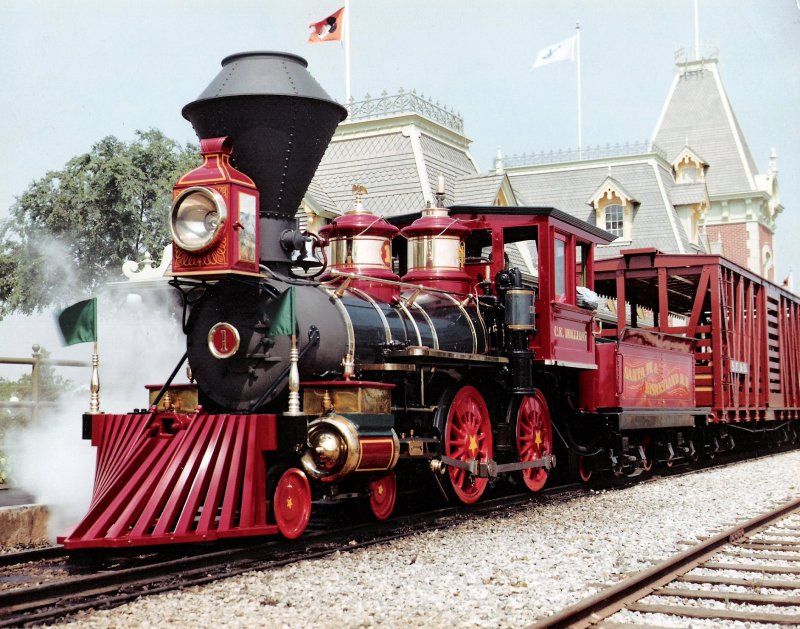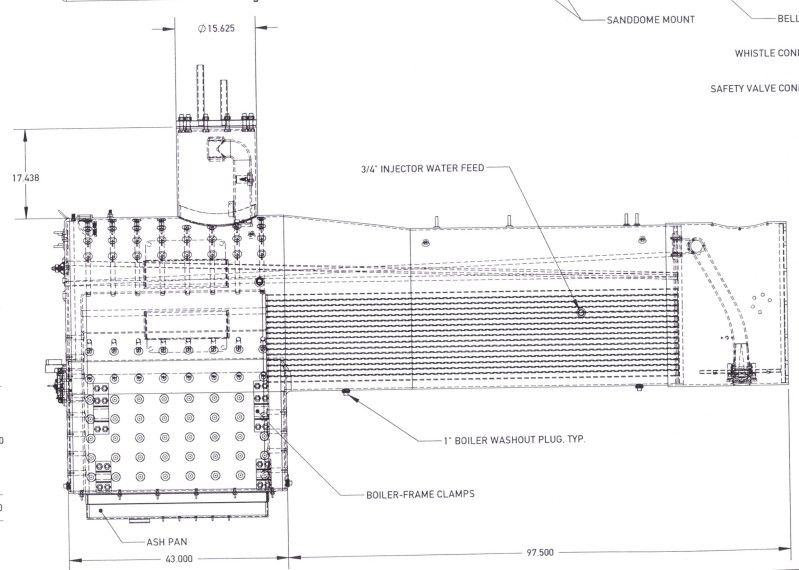As some of you here may know, I have a special fondness for the steam locomotives used at Disneyland in CA, and have written two books on the subject. The young man who prepared the CAD blueprint-style drawings in those books, Preston Nirattisai, has a new project that he’s developed—a “planbook” of blueprints of the Disneyland Railroad’s Engine No. 1, named the C.K. Holliday. Here’s a review of that planbook. Even if you’re not into the Disney trains, the drawings give a good look into the parts and construction of a typical 4-4-0 American.
Preston came to the United States from Thailand in 1995. But his first experience at Disneyland, when he was eight years old, has led to a lifelong passion and fascination. Preston has always had the mind of an engineer, and back in 2002, unable to find accurate blueprints of one of his favorite attractions—the Haunted Mansion—he decided to create his own. He not only used detailed measurements for the major dimensions, but he also delved into the Mansion’s history so deeply that he was able to find that the pattern used for the wrought-iron railings still existed. He wove those designs into his drawing, which led to one of the most-accurate renderings of the structure available outside Disney.
Back in 2002, I stumbled on these drawings. I was in the midst of writing my first book on the Disneyland Railroad, and I didn’t have the talent or knowledge to create any blueprint-style drawings of the trains. I had a single drawing of my favorite engine, the E.P. Ripley, crudely done in pencil, but I knew that one drawing wouldn’t suffice. So, I contacted Preston about doing the drawings I needed using much-more accurate CAD software. We met at, appropriately, Disneyland and discussed the project. Preston agreed, and we became fast friends.
Over the course of that friendship, I learned a lot about Preston—first and foremost, that he had a favorite engine of his own—the C.K. Holliday. Although maybe he won’t admit it, but perhaps the prospect of getting to draw the engine led to his agreeing to help me with the drawings in the book.

Because of those drawings, Preston was hired by Paul Boschan of Boschan Boiler and Restorations, the company that rebuilt the Ward Kimball locomotive. Paul had seen Preston’s drawings, and wanted to utilize his talents to have Preston do some drawings necessary for the Ward Kimball engine. With this, Preston gained valuable practical experience.
Preston eventually went on to receive an engineering degree from Cal State University Northridge, somehow managing to crew aboard the tall ship Lady Washington for a few years. He and his girlfriend Lynne settled down, and things seemed quiet over the past few years. We didn’t hear much from Preston. But he never gave up his passion for CAD drawing and computer modeling, nor his love of the C.K. Holliday. In his downtime, he’s been doing something quite extraordinary: He’s been informally training himself to be an amateur steam locomotive draftsman, and his first subject has been the C.K. Holliday.
Let me explain: Anyone can make a drawing of a steam locomotive—even me. What Preston has done is engage in the study of old steam engines, primarily using an ancient textbook called “Modern Locomotive Construction 1892,” by J.G.A. Meyer. More than a treatise on old steam engines, it is full of complex mathematical formulas and equations that were necessary to build the “modern” steam locomotives of the 1890s—precisely the information Preston needed to create the most accurate and detailed virtual model of the C.K. Holliday in existence. Using advanced computer software, the “parts” Preston created in the program would have to work flawlessly together. Any seemingly insignificant mis-match in measurements or dimensions would result in an un-workable model—everything had to be 100% correct.

Over the past two years, Preston has been meticulously re-creating every major component of the C.K. Holliday from the frame up. Disney, or course, would never release a drawing of the engine. However, many major and minor dimensions are known, and with these, using additional material from Meyer’s book, a complete virtual working model was constructed.
Please remember—Preston has no formal education in steam locomotive design or theory. To his amazing credit, Preston was able to animate some of the most complex mechanical movements of this engine—such as the Stephenson valve gear—and have it work exactly as it was meant to—this despite Preston never actually having seen such valve gear in motion. The completed model, and many of Preston’s animated sub-assemblies and construction snapshots, can be found on his blog at http://whiskeybeforebreakfast.wordpress.com/
As more and more people mistook Preston’s virtual model for an actual, real-world piece, it became apparent that there might be more than a passing interest from others to create their own model of the C.K. Holliday. So Preston took the major drawings of the external parts and put them into what I have called his “Magnum Opus:” A professionally-produced planbook that can be used by anyone who wants to create what would be the most accurate model ever of the Holliday. As Preston writes, “The drawings are a ‘mechanically true’ representation of the engine, meaning that each part of the engine was built separately and then fitted together in the computer using simulated fastening methods (such as bolts and welds) that are accurate to the real engine. This method allows proper fitting of the parts and checking for interferences…Should a model be built, mechanical sizes and movements such as the eccentrics, slide valve and gear, and even the throttle valve, will be accurate to the real engine.”

The planbook Preston created is an impressive piece of work that should appeal to a wide audience—rail fans, Disney fans and Disneyland Railroad fans. It is nearly 100 pages long, printed (NOT copied) in an 11” x 17” format, with a spiral binding that allows the pages to be laid flat on a working surface (when laid flat, it is nearly three feet long!). There is a back cover and a clear front cover. The planbook contains a large-format drawing of every major and minor part one would need to construct an actual model, with every single dimension clearly noted. And when I say “every part,” I mean it: You’re going to get drawings ranging from large assemblies such as the boiler, air compressor, smokestack, bell, bell cradle, steam gauge, cab, pilot and drive wheel, down to the smallest parts such as axles, cylinder cocks and even a detail of the individual teeth on the reverse lever quadrant! There are also beautifully rendered large drawings of the complete engine from several vantage points, as well as a cutaway showing the boiler internals.

This planbook looks very much like the actual planbooks Disney has stored at the Park for each of their five steam locomotives. In those planbooks, every single part needs to have a corresponding drawing with dimensions, because should any single part wear out or break, a new one would need to be created. There is no “Auto Zone” for steam locomotive parts, so accurate drawings are considered highly important. The dimensions for any given part must be accessible whenever needed—no matter the size or seeming importance of the part. Preston understands this intimately: I remember seeing one of his first drawings for one of the Ward Kimball parts. No, it wasn’t the headlight housing or a steam dome: It was the drawing of a single, lowly, threaded bolt: But that drawing was necessary and important, should one ever need to be re-created for the engine.

Preston used that knowledge to good use in this planbook. Certainly Preston has re-created the look of the actual Disney planbooks, utilizing an alpha-numerical reference border and a text block at the lower right of each drawing that has the title of the part being portrayed. But making this planbook better than the actual Disney versions are the isometric drawings with callouts that identify each of the major external components, as well as several pages of explanatory text at the beginning, and scatted throughout. There is a contents page as well to make it easier to go right to the part drawing you’re looking for.
This work is invaluable to fans of Disneyland first steam engine; but they will be equally valuable to folks who simply want to have a better understanding of the mechanics of steam locomotives, and the C.K. Holliday is nice, fairly simple engine from which to gain this understanding. The C.K. Holliday planbook has a selling price of $117--not cheap, but this is money well-spent; there aren’t likely to be many copies issued, and the sheer amount of work Preston undertook certainly makes this a reasonable price. You can order your copy at http://ckhollidayplans.com.
If you are a fan of the Disneyland Railroad, steam locomotives and the C.K. Holliday in particular, make sure to get your copy while they’re available. You may find yourself, as I did, spending hours simply studying the minute detail rendered on this collection of beautiful drawings.


